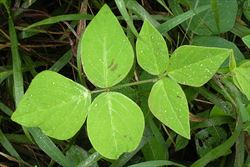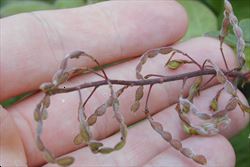Click on images to enlarge

infestation (Photo: Forest and Kim Starr, USGS)

habit (Photo: Forest and Kim Starr, USGS)

habit (Photo: Forest and Kim Starr, USGS)

compound leaves with three leaflets (Photo: Chris Gardiner)

close-up of leaves showing darker spots (Photo: Forest and Kim Starr, USGS)

flowers and flower buds (Photo: Forest and Kim Starr, USGS)

immature fruit (Photo: Forest and Kim Starr, USGS)

close-up of seeds (Photo: Steve Hurst at USDA PLANTS Database)
Scientific Name
Desmodium intortum (Mill.) Urb.
Synonyms
Hedysarum intortum Mill.
Family
Fabaceae (Queensland, the ACT, Victoria, Tasmania, and the Northern Territory)Fabaceae: sub-family Faboideae (New South Wales)Leguminosae (South Australia)Papilionaceae (Western Australia)
Common Names
beggarlice, green leaf desmodium, green-leaf desmodium, greenleaf desmodium, greenleaf tick trefoil, greenleaf ticktrefoil, green-leaved desmodium, tick clover
Origin
Native to Mexico, Central America (i.e. Belize, Costa Rica, El Salvador, Guatemala, Honduras, Nicaragua, Panama), the Caribbean (i.e. Hispaniola, Jamaica and Puerto Rico) and South America (i.e. Venezuela, Colombia, Ecuador, Peru and some parts of Brazil).
Naturalised Distribution
Naturalised in some parts of eastern Australia (i.e. in south-eastern and northern Queensland and in the coastal districts of northern New South Wales).
Also naturalised on some Pacific islands (i.e. the Galapagos Islands, Hawaii and New Caledonia).
Notes
Greenleaf desmodium (Desmodium intortum ) is regarded as an environmental weed in Queensland and northern New South Wales. It was recently listed among the top 200 most invasive plants in south-eastern Queensland and is mainly a concern in riparian vegetation, due to its shade tolerance and its ability to climb over other plants.

